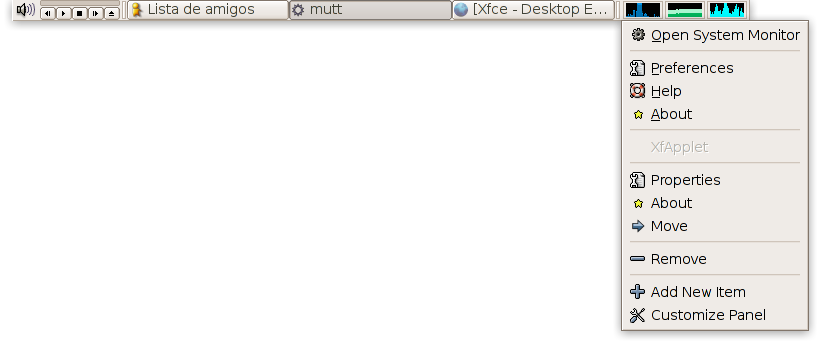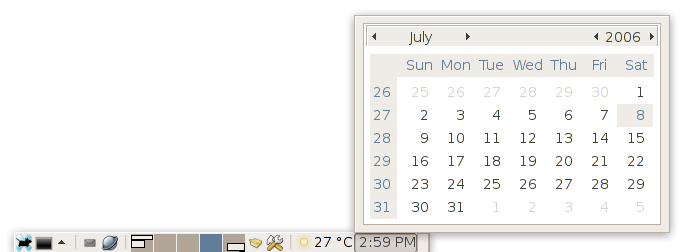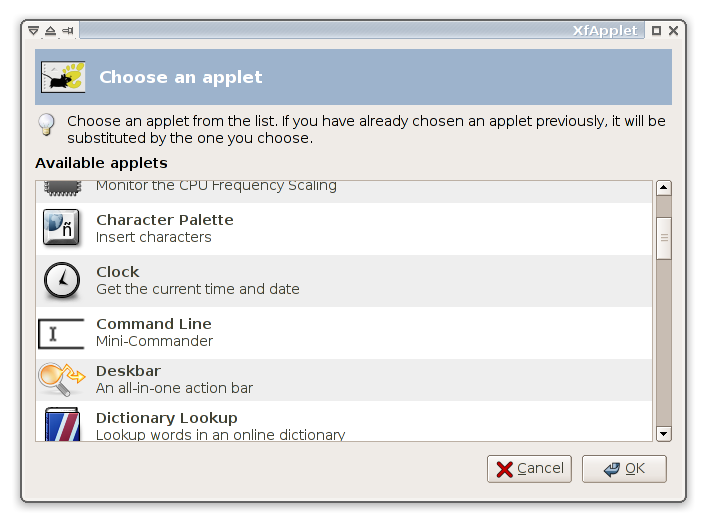Table of Contents
XfApplet
About
The XfApplet Plugin is a plugin for the Xfce 4 Panel which allows one to use applets designed for the Gnome Panel inside the Xfce Panel. You can think of XfApplet as a tiny Gnome Panel that lives inside the Xfce Panel and allows you to show the same applets that the Gnome Panel is capable of showing.
The current stable version of the XfApplet Plugin has the following features:
- Most Gnome applets are supported. Basically the only exceptions are the Gnome Systray and Window List applets, which should be considered not very well supported. This should be fixed in the next stable version;
- The XfApplet properties dialog allows you to choose between all Gnome applets currently installed, just as the Gnome Panel does.
- The XfApplet context menu shows both the Xfce Panel related items (such as “Move”, “Remove”, “Customize Panel”, etc.) and the Gnome applet ones, which of course will depend on the specific applet being displayed.
- Applets are displayed correctly in terms of layout, popup menus and other issues no matter the Xfce Panel specific configuration such as position (top, bottom, left or right side and floating) and size.
By now you may be wondering: why would someone write XfApplet? The motivations for both starting and maintaining this project can be resumed as follows:
- Olivier Fourdan (Xfce project leader) was asked in his interview in FOSDEM 2005 about the possibility of integration between the Gnome Panel applets and the Xfce Panel. His answer stated that (by that time) the Xfce Panel did not support stand alone applets such as the Gnome Panel, but instead one could write a plugin for the Xfce Panel that was capable of showing Gnome applets.
- Software reusability is very common in FOSS projects, especially in code level. XfApplet allows for reusability in component level by linking against the Bonobo infra-structure and the Xfce Panel libraries. So there's no need to rewrite every single Gnome applet against Xfce libraries; all of them can be used out of the box from within both the Xfce and Gnome panels.
- Many new Xfce users come from Gnome or at least have a good Gnome experience. The possibility of using Gnome applets inside the Xfce Panel makes the experience of moving from Gnome to Xfce or even using both desktop environments easier.
Usage
Using XfApplet is quite easy, specially because XfApplet itself doesn't have any special functionallity; its only purpose is to display Gnome applets. To learn how to use a specific Gnome applet you will have to refer to the applet's particular documentation.
Assuming that you have properly built and installed XfApplet, you need only to right click the Xfce Panel and choose “Add New Item”. You should find the XfApplet Plugin in the list of available plugins for the Xfce Panel.
After adding XfApplet to the Xfce Panel (either by clicking “Add” or by drag and drop), you'll get an empty XfApplet. An empty XfApplet displays nothing but a small icon with the Xfce mice and the Gnome foot. Right click the icon and choose “Properties”. This will open the XfApplet properties dialog where you will be able to choose any Gnome applet installed by either double clicking it or hitting “OK”.
At any time you can change the applet displayed through the XfApplet properties dialog. Each instance of XfApplet is capable of displaying only one Gnome applet; so if you want to display several applets you will have to add a XfApplet instance for each one of them.
Screenshots
Everybody loves screenshots and some say that seing is believing, so here they are. The following Xfce Panel screenshot shows a top centered panel containing the following items, from left to right: the Gnome Volume applet, the Gnome XMMS applet, the Xfce Task List plugin and the Gnome System Monitor applet (displaying CPU, memory and network statistics). All Gnome applets are, of course, being displayed through XfApplet (the Task List plugin is Xfce native). You can also notice in the context menu that both the Xfce Panel related items and the applet ones are displayed.
The following Xfce Panel screenshot shows a bottom centered panel mixing several native Xfce plugins with some Gnome applets. From left to right we have: the Xfce Menu plugin, a terminal launcher, a separator, the Mailwatch plugin, a web browser launcher, a separator, the Pager plugin, the Gnome Sticky Notes applet, a Xfce Settings launcher, a separator, the Gnome Weather applet, the Gnome Calendar applet and the Xfce Systray plugin (almost unnoticeable).
Finally, the following screenshot shows the XfApplet properties dialog, where one can choose the applet to be displayed. This dialog resembles the Xfce Panel “Add New Item” dialog; the idea behind it is that adding applets should be just like adding native Xfce Panel plugins.
Releases
Xfce 4.4
Dependencies
In order to use XfApplet, you will need Xfce Panel >= 4.4b1. XfApplet should also work fine with the current development version of Xfce Panel (4.3.x) provided that you have an SVN revision >= r19874. Libxfce4util e Libxfcegui4 are also required. From the Gnome side, you will need Libpanelapplet and its own dependencies. Make sure you have ORBit2 >= 2.12.5.
Reporting Bugs
Bugs should be reported to the Xfce bug tracking system (product Xfce Panel plugins, component xfapplet).


